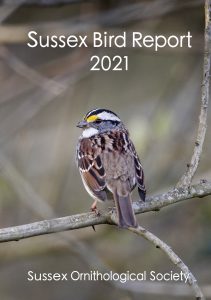Thanks to the enthusiasm and dedication of so many amazing volunteers 184 squares have been surveyed for the BBS in the Sussex region this year which is a new record!
Available here are trend graphs plotted for 36 common species using Sussex BBS data for 1994 to 2021; these can be compared with national and regional trend graphs available at http://www.bto.org/volunteer-surveys/bbs/latest-results/trend-graphs. The trend graphs are plotted using the percentage changes each year since the start of the survey in 1994, presented as indices relative to an arbitrary index of 1.0 in 1994. Some of the graphs show encouraging stability of population levels or even increases. House sparrow and song thrush numbers in Sussex appear to be increasing slightly after years of stability, and the long-term declines in starling and mistle thrush numbers appear to have halted. Population levels of skylarks and yellowhammers in Sussex appear to be more or less stable. Obviously the real concerns are cuckoo, chaffinch, greenfinch and swift; the real value of the BBS is in identifying these most seriously declining species.
Now is a good time of the year to consider taking part in the BBS, because if you take on a square you will also have the option to take part in the Sussex Winter Bird Survey (SWBS) by surveying the same square over the coming winter, beginning on 1 November 2022.
The BBS is a national monitoring scheme administered by the BTO and jointly funded by the BTO, JNCC and RSPB. It has been running since 1994 and its primary aim is to provide population trends for common and widespread bird species in the UK. Population trends for Sussex are also produced annually. Survey plots are randomly-selected 1-km squares of the National Grid, and the same squares are surveyed each year. Volunteers visit their squares three times each year during the breeding season, once to record simple habitat data, and twice to walk a fixed route, recording birds seen and heard. There are more than 200 BBS squares across Sussex, covering every type of habitat, and new volunteers are always needed. Volunteers must be able to recognise common and widespread birds, but previous experience of survey work is not necessary. Help and support from experienced volunteers can be arranged if required, and some informal group practice sessions will hopefully be planned for March 2023 to which new volunteers will be invited.
The BBS squares (asterisks indicate priority squares that have been surveyed before) in Sussex which currently need volunteers for the 2023 breeding season are (updated 6/1/2023):
SU7800 near West Itchenor
SU7808 near Woodmancote*
SU8102 near Bosham Hoe*
SU8307 near West Stoke*
SU8527 near Milland*
SU8602 Chichester Canal*
SU8605 central Chichester*
SU8612 West Dean
SU8624 Tote Hill near Midhurst
SU8926 Henley Common
SU9113 near East Dean*
SU9127 near Fernhurst*
SU9207 near Boxgrove*
SU9304 Westergate*
SU9729 near Northchapel*
SZ7996 East Wittering*
SZ8199 near Birdham
SZ8696 Pagham Harbour*
SZ8698 Sidlesham*
TQ0124 near Kirdford*
TQ0503 north Rustington*
TQ2022 Cowfold*
TQ2122 Cowfold*
TQ2536 Gossops Green
TQ2638 Langley Green*
TQ2733 Tilgate Forest*
TQ2828 Staplefield*
TQ2836 central Crawley
TQ4612 near Ringmer*
TQ4738 near Blackham*
TQ4821 Uckfield*
TQ4938 near Blackham*
TQ5026 High Hurstwood
TQ5128 near Crowborough*
TQ5130 central Crowborough
TQ5220 Blackboys*
TQ5228 near Crowborough*
TQ5435 near Eridge Station*
TQ5511 Lower Dicker*
TQ5738 Tunbridge Wells*
TQ5829 near Mark Cross*
TQ5901 Willingdon*
TQ6419 Earl’s Down*
TQ7111 near Ninfield*
TQ7811 Hollington*
TQ8326 Northiam Station*
TQ8413 near Three Oaks
TQ8518 Udimore*
TQ8722 Peasmarsh*
For further information, please contact Helen Crabtree at hcrabtree@gmail.com.
